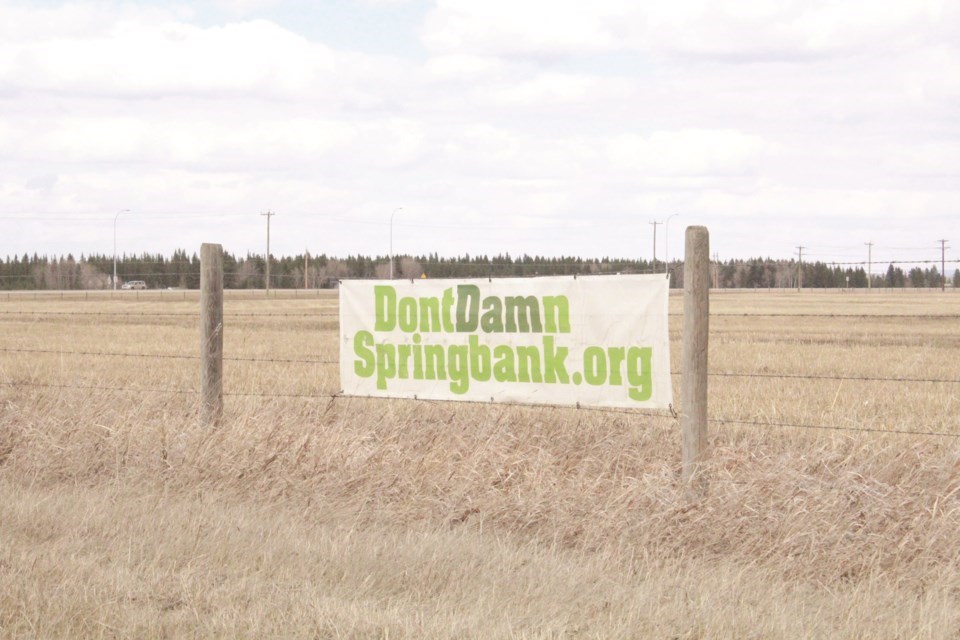The Springbank Off-stream Reservoir (SR-1) flood protection project has entered the beginning stages of construction, following alleged voluntary agreements reached with local landowners to secure 100 per cent of the land needed for the project.
As part of Alberta’s Recovery Plan, a governmental economic initiative to build diversity and create jobs across the province, the construction of the reservoir is set to begin in early 2022, with completion estimated for 2025.
Earlier this year, both provincial and federal regulators gave the go-ahead to the proposed $432 million project, deeming it to be in the public interest.
“The way things have been going in terms of natural disasters, it was very imperative that we start thinking about what our options are,” said Rajan Sawhney, Alberta’s minister of transportation. “The [2013] floods really impacted downtown Calgary and resulted in billions of dollars of damage and loss of life.
“The damage that was sustained [then] and the impact on lives was substantial, and it became very apparent we needed some flood mitigation put into place, even though it was a once-in-a-century event.”
Sawhney added several stakeholders and elected officials came together a few years ago to discuss flood mitigation and prevention options following the devastating floods. While several options were assessed, the Springbank Off-stream Reservoir project was ultimately approved, and a regulatory review began thereafter.
But the project has been contentious from the start, according to Sawhney.
“Local landowners were not very happy and there was a lot of vocal opposition,” she said, adding Springbank, Elbow Valley and Bragg Creek residents preferred a reservoir option at nearby McLean Creek that would have been less impactful to them.
“As a landowner who lives in one of the most beautiful areas of the province, you can only imagine how [they] felt knowing their land would have to be bought or expropriated if it came to that to ensure that we could build this dam,” Sawhney said.
“Where you live, your land, your property, it’s close to the heart, so there are a lot of emotions attached to it.”
Sawhney said following approvals from regulatory bodies, she believes residents now realize the project is necessary, and in the public interest.
“What benefits Calgarians also benefits people who live in Springbank,” she said. “A lot of those folk work in downtown Calgary and have children, perhaps in schools in or near the city.
“I’m very grateful to all the landowners and stakeholders who came together and made sure we could move to the next steps cleanly and without controversy.”
According to the Alberta government website, the project has been designed to work together with the Glenmore Reservoir in Calgary to accommodate water volumes equal to the 2013 flood on the Elbow River.
The reservoir is supposed to provide flood protection along the Elbow River in Calgary and other downstream communities as part of an overall flood mitigation system. It aims to reduce flood risk by managing downstream river flow rates and volume, while protecting the river, critical habitats, fish and wildlife.
Karin Hunter, Springbank Community Association president, said residents didn’t start out opposed to the reservoir project, but ended up with some serious reservations throughout the years-long planning and consultation process.
“We started out curious about how the project would impact our community and once we started to wrap our heads around the size of [the project] and how the operations would affect our community, it raised a whole litany of issues,” she said.
Hunter added the community continues to raise concerns about the air quality and environmental impacts of SR-1 that cannot be fully addressed by the government, due to the nature of the project.
“We remain concerned, and we’re disappointed that it’s moving forward,” she said. “But the government had its full weight behind the project since day-one, and so it’s a difficult situation to be in.”
Hunter said the government reached agreements with most landowners, though she is skeptical that any title changes have occurred.
“I would be surprised if those deals are set in stone at this point,” she said. “There were no voluntary sales here … most landowners held out to the bitter end and their hands were sort of forced by the government.
“There were very few landowners that sold voluntarily, especially the ones here at the end [who] were left with very little alternative – the pressure of the government and threat of expropriation is significant and hard to combat.”
According to Hunter, the community has requested transparency regarding costs and land acquisition surrounding SR-1 from the beginning, and she claimed the government has failed to provide that.
“If we could have transparency from the Alberta government, that would be really great at this point,” she said. “Knowing what we know and how [they] operate, we’re not optimistic that we’ll get any transparency.
“Given this is a publicly funded project – well over half a billion dollars – I think it’s something taxpayers deserve to know.”
Hunter added the community association will be working with the National Resource Conservation Board to determine how the acquired and excess land will be used following the completion of SR-1.
“We would like to see there is community use of what is now a huge chunk of crown land sitting within and surrounded by Springbank,” she said. “We’ll be watching to see that land use is appropriate.”
Carmen Cundy, AirdrieToday.com
Follow me on Twitter @carmenrcundy



